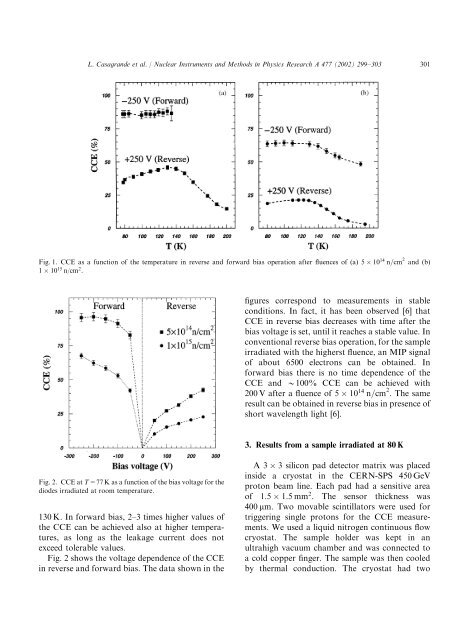Nuclear Instruments and Methods in Physics Research A - F9
Nuclear Instruments and Methods in Physics Research A - F9
Nuclear Instruments and Methods in Physics Research A - F9
You also want an ePaper? Increase the reach of your titles
YUMPU automatically turns print PDFs into web optimized ePapers that Google loves.
L. Casagr<strong>and</strong>e et al. / <strong>Nuclear</strong> <strong>Instruments</strong> <strong>and</strong> <strong>Methods</strong> <strong>in</strong> <strong>Physics</strong> <strong>Research</strong> A 477 (2002) 299–303 301Fig. 1. CCE as a function of the temperature <strong>in</strong> reverse <strong>and</strong> forward bias operation after fluences of (a) 5 10 14 n=cm 2 <strong>and</strong> (b)1 10 15 n/cm 2 :figures correspond to measurements <strong>in</strong> stableconditions. In fact, it has been observed [6] thatCCE <strong>in</strong> reverse bias decreases with time after thebias voltage is set, until it reaches a stable value. Inconventional reverse bias operation, for the sampleirradiated with the higherst fluence, an MIP signalof about 6500 electrons can be obta<strong>in</strong>ed. Inforward bias there is no time dependence of theCCE <strong>and</strong> B100% CCE can be achieved with200 V after a fluence of 5 10 14 n=cm 2 : The sameresult can be obta<strong>in</strong>ed <strong>in</strong> reverse bias <strong>in</strong> presence ofshort wavelength light [6].3. Results from a sample irradiated at 80 KFig. 2. CCE at T=77 K as a function of the bias voltage for thediodes irradiated at room temperature.130 K. In forward bias, 2–3 times higher values ofthe CCE can be achieved also at higher temperatures,as long as the leakage current does notexceed tolerable values.Fig. 2 shows the voltage dependence of the CCE<strong>in</strong> reverse <strong>and</strong> forward bias. The data shown <strong>in</strong> theA3 3 silicon pad detector matrix was placed<strong>in</strong>side a cryostat <strong>in</strong> the CERN-SPS 450 GeVproton beam l<strong>in</strong>e. Each pad had a sensitive areaof 1:5 1:5mm 2 : The sensor thickness was400 mm. Two movable sc<strong>in</strong>tillators were used fortrigger<strong>in</strong>g s<strong>in</strong>gle protons for the CCE measurements.We used a liquid nitrogen cont<strong>in</strong>uous flowcryostat. The sample holder was kept <strong>in</strong> anultrahigh vacuum chamber <strong>and</strong> was connected toa cold copper f<strong>in</strong>ger. The sample was then cooledby thermal conduction. The cryostat had two















